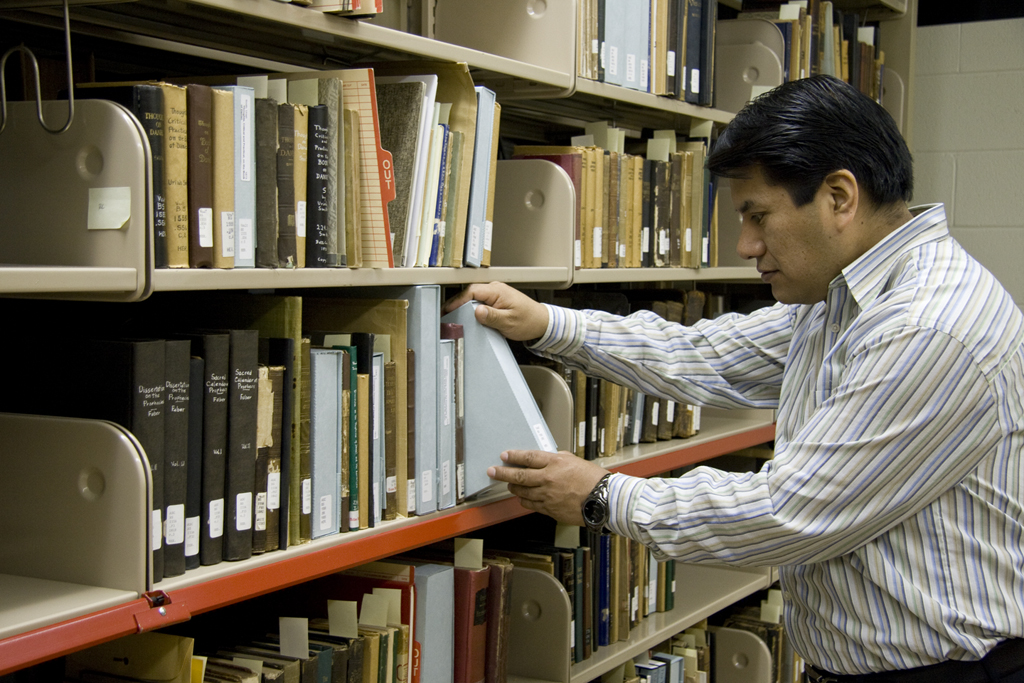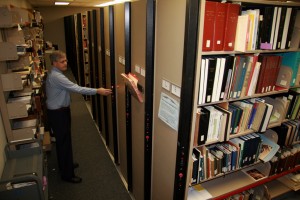Shelving is an integral part of any library type collection and this is no different at the Center for Adventist Research. Our diverse collections occupy many miles of shelving in various locations throughout the Center and even spilling over into other James White Library spaces. For a rapidly growing collection such as in CAR, space is always a problem that will arise sooner or later.
One method to alleviate space problems, at least for a while, is the use of what is called compact shelving. This consists of shelving units attached to a carriage that then rolls on a track. Using this style of shelving we can eliminate most of the aisles necessary to access the contents of a row of shelves because an aisle may be opened where it is needed. Typically compact shelving can nearly double the storage capacity for a given amount of floor space compared to the usual stationary shelving commonly found in libraries, warehouses, and other storage areas.
In the mid-1970s, when the James White Library was being renovated and doubled in size, at least two significant decisions were made that relates to what is now the Center for Adventist Research. One was the construction of a proper and large vault to protect the collection. The second decision was to install compact shelving in that vault as well as for the main book stacks of the Heritage Room, as it was called then.
In 2000, when the Center was last renovated, the main book stack compact shelving system was relocated into what is now the Center’s stack area. When Griggs University moved from Maryland to Andrews University in 2011 they had two compact shelving systems that would not work well in their new spaces. The Center had already been talking with University administration about our space needs especially in the University Archives area. When administration became aware of the availability of compact shelving they asked CAR if we could make it work for our needs. For only the cost of moving and installation we were able to add a significant amount of compact shelving in the far back area of our stacks significantly increasing our capacity. About half went for the University Archives and half for CAR storage.
As time marches on the Center has largely outgrown its ability to store anything but small additions to the collections. At this point any new large collection will pose a serious problem for us. The nearly doubling of the Center’s space at the 2000 renovation was largely in public areas and in providing adequate passage space between shelves, adding only a modest amount of extra storage capacity. So now we are largely out of space. Combine this state with a new occurrence and we are facing a real crisis in our storage areas. Recently the carriages with our main book collection have begun coming off their tracks. This has occurred repeated times in the past couple of years with more frequent incidents recently. When this happens we usually need to empty the whole range of shelves of all their books. With the lack of empty shelves elsewhere in the Center this is becoming a more difficult proposition. It also makes half of our book collection inaccessible until we can get the carriage back on the track.
We have determined the cause of the derailments to be a combination of the extremely poor engineering design of the compact shelving system combined with a deteriorating support foundation under the rails allowing the rails to sag under the weight. These factors combine to cause the derailments. The solution is to remove the carriages—and the shelves of books—and replace the rail system. However, the compact shelving system is electronically controlled. If you know much about electronics you will know that a nearly 40 year old electronic control is well beyond its reliable and useful lifespan. So we are really looking at needing to replace the current system with a new system, but this is very expensive. Center administration is working with University administration to find a solution to this problem.
We need to replace the malfunctioning system plus we need to expand our storage capacity. The only practical way to do this is to install compact shelving. This will help us for a number of years until we outgrow that. We need either a very large compact shelving system or more likely a multi-phase installation. The Center is likely to continue our heavy use of compact shelving for the foreseeable future.
Jim Ford, Associate Director / Jim enjoys gardening and often brings in the season’s bounty to share with co-workers.


